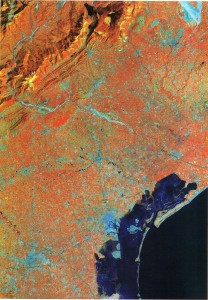
The Veneto region has very peculiar territorial characteristics that have determined a very strong socio-cultural and economic development in this part of Italy. Even in antiquity, Greek and Latin authors such as Polybius, Strabo, Livy and Pliny, just to mention a few of them, focussed on the close interrelationship between men and nature in this region.

Ripresa da satellite della regione veneta da cui si coglie chiaramente la successione composita di spazi marittimi, lagune, pianure, colline e montagne
The main geographical aspect which should be taken into account is not the morphology of the territory of the region, but its position. Veneto extends from the mountains to the northern part of the Adriatic gulf. Thus, Veneto has held a strategic position since prehistory and, because of this, it became the point of convergence of cultural and commercial trends coming from the central Mediterranean areas and going to the central-northern part of Europe. It was then essential for people coming form Atlantic Europe wanting to reach the Balkan regions to pass through Veneto. Veneto became a crossroads between the Mediterranean peninsular world, the central areas of the continent and the Eastern-Slavonic universe. From this convergence sprang the cultural identity of the region, whose marking signs had already begun to appear in the iron age (X-IX centuries BC) and which developed until the fall of the Venetian Republic (XVIII cent. AD). The specificity of the region found its first acknowledgment with the emperor August who established in the territory the X regio, which was later called Venetia et Histria by Diocletianus.
The main geographical peculiarity of Veneto could maybe identified with the rapid and drastic change in the landscape that shows lagoon and deltaic areas, wide plains, hills, the massif of the Pre-Alps and some of the Alps them selves.
Il testo e le immagini (con referenze fotografiche) sono tratti da:
J. Bonetto, I. Venturini, L. Zaghetto, Veneto, Archeologia delle Regioni d’Italia, Istituto Poligrafico e Zecca dello Stato, Roma 2009.












